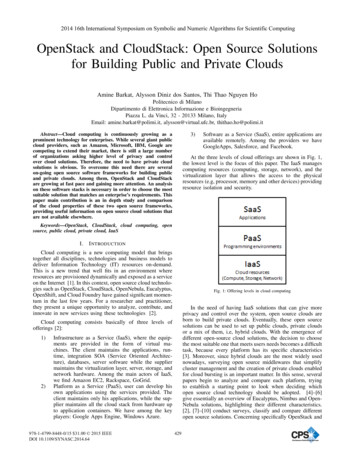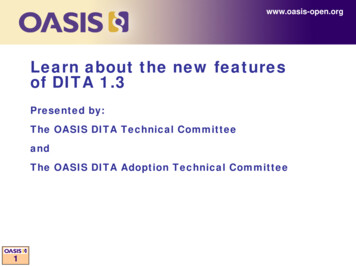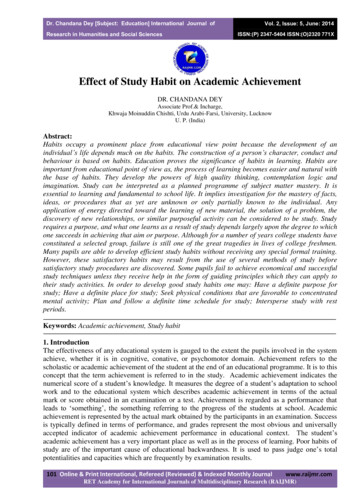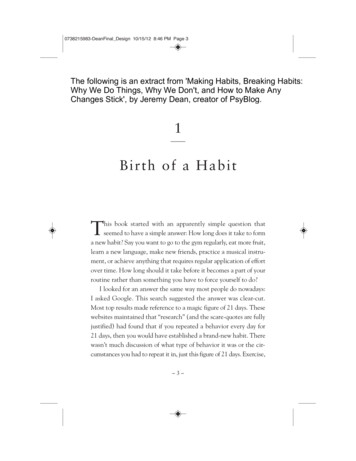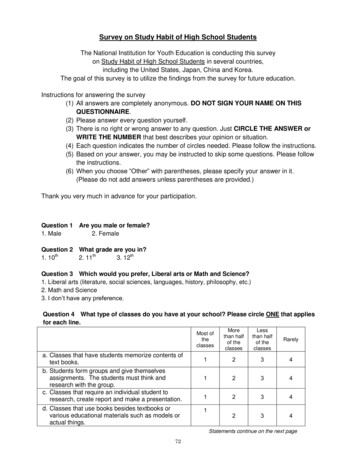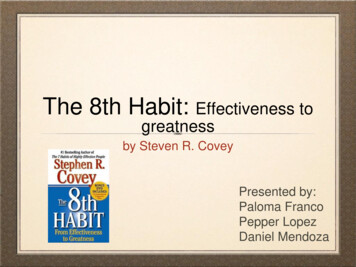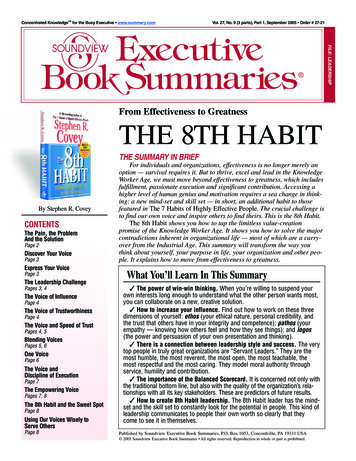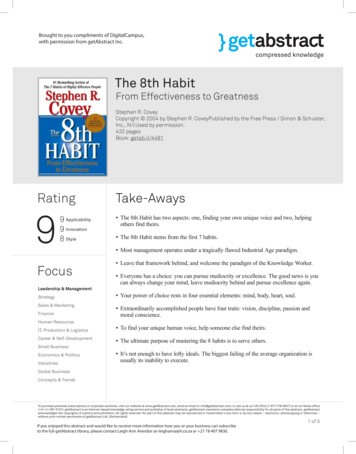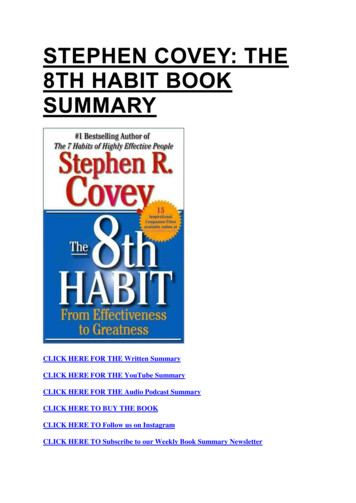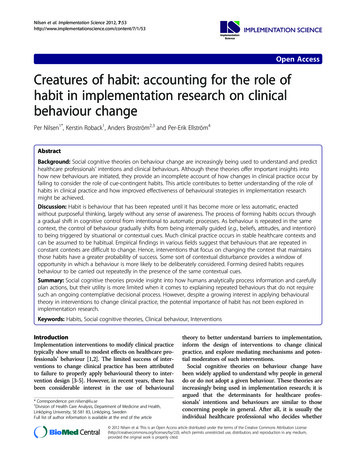
Transcription
Nilsen et al. Implementation Science 2012, /1/53ImplementationScienceOpen AccessCreatures of habit: accounting for the role ofhabit in implementation research on clinicalbehaviour changePer Nilsen1*, Kerstin Roback1, Anders Broström2,3 and Per-Erik Ellström4AbstractBackground: Social cognitive theories on behaviour change are increasingly being used to understand and predicthealthcare professionals’ intentions and clinical behaviours. Although these theories offer important insights intohow new behaviours are initiated, they provide an incomplete account of how changes in clinical practice occur byfailing to consider the role of cue-contingent habits. This article contributes to better understanding of the role ofhabits in clinical practice and how improved effectiveness of behavioural strategies in implementation researchmight be achieved.Discussion: Habit is behaviour that has been repeated until it has become more or less automatic, enactedwithout purposeful thinking, largely without any sense of awareness. The process of forming habits occurs througha gradual shift in cognitive control from intentional to automatic processes. As behaviour is repeated in the samecontext, the control of behaviour gradually shifts from being internally guided (e.g., beliefs, attitudes, and intention)to being triggered by situational or contextual cues. Much clinical practice occurs in stable healthcare contexts andcan be assumed to be habitual. Empirical findings in various fields suggest that behaviours that are repeated inconstant contexts are difficult to change. Hence, interventions that focus on changing the context that maintainsthose habits have a greater probability of success. Some sort of contextual disturbance provides a window ofopportunity in which a behaviour is more likely to be deliberately considered. Forming desired habits requiresbehaviour to be carried out repeatedly in the presence of the same contextual cues.Summary: Social cognitive theories provide insight into how humans analytically process information and carefullyplan actions, but their utility is more limited when it comes to explaining repeated behaviours that do not requiresuch an ongoing contemplative decisional process. However, despite a growing interest in applying behaviouraltheory in interventions to change clinical practice, the potential importance of habit has not been explored inimplementation research.Keywords: Habits, Social cognitive theories, Clinical behaviour, InterventionsIntroductionImplementation interventions to modify clinical practicetypically show small to modest effects on healthcare professionals’ behaviour [1,2]. The limited success of interventions to change clinical practice has been attributedto failure to properly apply behavioural theory to intervention design [3-5]. However, in recent years, there hasbeen considerable interest in the use of behavioural* Correspondence: per.nilsen@liu.se1Division of Health Care Analysis, Department of Medicine and Health,Linköping University, SE-581 83, Linköping, SwedenFull list of author information is available at the end of the articletheory to better understand barriers to implementation,inform the design of interventions to change clinicalpractice, and explore mediating mechanisms and potential moderators of such interventions.Social cognitive theories on behaviour change havebeen widely applied to understand why people in generaldo or do not adopt a given behaviour. These theories areincreasingly being used in implementation research; it isargued that the determinants for healthcare professionals’ intentions and behaviours are similar to thoseconcerning people in general. After all, it is usually theindividual healthcare professional who decides whether 2012 Nilsen et al. This is an Open Access article distributed under the terms of the Creative Commons Attribution ), which permits unrestricted use, distribution, and reproduction in any medium,provided the original work is properly cited.
Nilsen et al. Implementation Science 2012, /1/53or not to perform a specific clinical behaviour, such asprescribing an antibiotic for a sore throat, adhering to ahygiene recommendation, conducting a treatment follow-up, or providing advice on alcohol consumption.This article highlights the lack of consideration of therole of habit in social cognitive theories used in implementation research. Habits are automatic responses tocontextual cues, acquired through repetition of behaviour in the presence of these cues [6-9]. We argue thathabit is a critical variable in understanding clinical practice change because healthcare professionals’ daily practice is predominantly habitual and therefore difficult tochange through many conventional implementationinterventions. The overall aim is to contribute to betterunderstanding of the role of habits in clinical practiceand how improved effectiveness of behavioural strategiesin implementation research might be achieved.Social cognitive theories and habitsSocial cognitive theories are the dominant theories usedin clinical behaviour change research. The Theory ofReasoned Action [10], the Social Cognitive Theory [11],the Theory of Interpersonal Behaviour [12], and the Theory of Planned Behaviour [13] have been applied to identify variables that underlie healthcare professionals’behaviours and to predict behaviour change. A systematic review by Godin et al. [5] identified 76 studies thatused social cognitive theories to understand and predicthealthcare professionals’ intentions and behaviours. Themost commonly used theories were Theory of ReasonedAction and Theory of Planned Behaviour (essentially anextension of the Theory of Reasoned Action). Godinet al. [5] concluded that the Theory of Planned Behaviour was the most appropriate theory to predict behaviour, whereas other theories better captured factors thathave an impact on behavioural intention.Many social cognitive theories view intention as thekey predictor of behavioural enactment. Intention refersto an individual’s motivation concerning the performance of a given behaviour. Research on population andpatient behaviour change suggests that intention is arelatively good indicator of behaviour in longitudinalstudies, but generally leaves 50 % to 60 % of the variancein behaviour unexplained [14]. Two systematic reviews[5,15] of the relationship between intention and clinicalbehaviour found only 16 studies, but suggested that thenature of the relationship was similar to that of nonhealthcare professionals. The strength of the intention–behaviour relationship was found to vary depending onfactors such as the specific clinical behaviour understudy, professional category and whether self-reported orobservational measures were used [5].Overall, findings in different fields indicate a rathersubstantial intention–behaviour gap. Although someonePage 2 of 6with strong intentions to perform a given behaviour ismore likely to enact the behaviour in question thansomeone with weak intentions, many people with strongmotivation do not behave in accordance with thisintention [14]. Numerous studies in various behaviouraldomains (including blood donation, seat belt use, choiceof travel mode, and fast food purchase) have shown thatthe connection between intention and future behaviouris moderated by the degree to which the current behaviour is habitual; the utility of intention as a predictor ofbehaviour declines as habit strength increases [16-18].Inherent in many social cognitive theories is the assumption that intention and hence behaviour can beinfluenced by the provision of appropriate informationconcerning a behaviour. Commonly used interventionsin implementation research include dissemination ofprinted materials, such as guideline recommendationsand various forms of education, including continuingmedical education and educational outreach [4]. However, a growing body of research shows that individualswho have developed habitual behaviours become lesslikely to act on new information and may even avoid information that challenges the present behaviour [18].People appear to form expectations for certain outcomesas behaviours become habitual, something that tends toreduce their sensitivity to change in a context that mightotherwise result in new behaviour; people may overlookalternatives simply because their ongoing expectationsreduce their awareness of new information [19-21]. Essentially, habits yield tunnel vision, thus reducing the effectiveness of interventions aimed at changing behaviourthrough conscious cognitive deliberation.Social cognitive theories can offer insight into howhumans analytically process information and carefullyplan actions, but their utility is more limited when itcomes to explaining repeated behaviours that do not require such an ongoing, contemplative decisional process[22]. Research on consumer habits suggests that mosteveryday activities are behaviours that we repeat overand over again. It has been estimated that approximately45 % of everyday behaviours tend to be repeated in thesame physical location every day [23]. In familiar andunvarying settings, behaviour tends to be guided moreby habit than intention, but in novel or changing contexts behaviour will be regulated by intention; wherehabit and intention conflict, behaviour is more likely toproceed in line with habit than intention [24].Understanding habitHabits have been studied extensively in the behaviouristtradition. Behaviourists consider habit as repeated behaviour that is established through learning. The behaviourist view posits a direct relationship betweensituation (stimulus) and behaviour (response). Explicit
Nilsen et al. Implementation Science 2012, /1/53rewards are required after a response to a situationalcue. The probability that a situation will elicit a behaviour depends on the frequency of performing the behaviour in the situation [25-28].However, the conceptualization of habit strength asfrequency of past behaviour is increasingly being disputed. Some behaviours turn quickly into habits,whereas others may require painstaking practice and frequent repetition. And although habitual behaviour maybe frequently performed, frequent behaviour is not necessarily habitual [23,29,30]. Thus, behavioural recurrence does not constitute direct evidence for habitualbehaviour. There is also recognition that rewards are notnecessary for habit formation when a behaviour is intrinsically rewarding. In fact, providing external rewards canreduce intrinsic motivation to continue to perform a behaviour, thus hindering the habit formation process [31].A new conceptualization of habit is emerging that differs from behaviourism by going beyond habit as merelyrepeated behaviour. More attention is paid to the automaticity aspect of habitual behaviour. There is generalagreement that habits are automatic in the sense thatthey are enacted without purposeful thinking, largelywithout any sense of awareness, and can be performedquickly in parallel with other activities [23]. While habitsform through repeated performance in unvarying settings, and many habits are performed frequently, severalresearchers consider that, once formed, the ‘active ingredient’ of habit is automaticity. This viewpoint presentsbehaviour frequency as a precursor and possible consequence of automaticity, rather than a part of the construct habit itself [9,32].Definitions of habit that account for an automaticitydimension are consistent with so-called dual processingmodels, which distinguish between two distinct modesof reasoning and information processing. The automaticmode is typically described as fast, intuitive, and heuristic, whereas the intentional mode is characterized as rational, deliberate, slow, rule-based, and explicit. Themodels posit that the two processes are in constant operation as humans reason [33-35]. Sladek et al. [36] suggested that dual processing models can be applied forimproved identification of factors that influence the uptake of new evidence by physicians.Forming and breaking habitsThe process of forming habits occurs through a gradualshift in cognitive control from intentional to automaticprocesses. When a behaviour is performed many times,humans begin to use a sort of heuristic decision-makingstrategy, i.e., a cognitive shortcut whereby we do notneed to scrutinize all the consequences of enacting acertain behaviour [37]. As behaviour is repeated in thesame context, the control of behaviour gradually shiftsPage 3 of 6from being internally guided (e.g., beliefs, attitudes, andintention) to being triggered by situational or contextualcues, such as automatically looking both ways beforecrossing the street, strapping on the seat belt whenentering a car, or saying ‘amen’ at the end of a publicprayer in church. Wood and Neal [7] describe this as‘outsourcing’ of behavioural control to contextual cues.A shift from deliberate to automatic processes has beenfound across a broad range of social behaviours [38].Provided that the context remains the same and the response satisfies the person’s objectives, these associationsacquire a degree of automaticity [6]. The context is theenvironment in which behaviour takes place; the featuresor cues that trigger action can be anything from physicalobjects and preceding actions to geographical features orpeople [16].Empirical findings in various fields suggest that behaviours that are repeated in constant contexts are difficultto change [39-41]. Hence, interventions that focus onchanging the context that maintains those habits have agreater probability of success. Some sort of contextualdisturbance provides a window of opportunity in whicha behaviour is more likely to be deliberately considered.This effectively makes behaviour-relevant informationmore salient and influential [18,20,40]. This is clearly inline with Dewey’s [42] view of learning as a process thatbegins with a perceived difficulty or disturbance in aroutinized task or situation. To some extent, it is alsorelated to Heidegger’s [43] concept of unreadiness-tohand, i.e., an unpredicted disturbance that makes usrecognize and see things we do not normally notice orhave come to take for granted (presence-at-hand). Therelative effectiveness of reminders (signals before or during performance of a behaviour) as a clinical behaviourchange intervention [44] can be attributed to such acontextual disturbance mechanism [45].Different types of interventions are needed to disruptunwanted habits and/or to promote desired habits thanthose used to modify behaviour through conscious cognitive deliberation, as depicted by social cognitive theories.Because habits are triggered automatically in response tocontextual cues, breaking ‘bad’ habits can be achieved byeither removing persons from the environment that cuesunwanted habitual responses or by modifying the context,e.g., placing reminders in the environment. Research alsosuggests that vigilant monitoring can offer a means ofinhibiting habits because it enables the individual to identify cues and exert control in order to reduce unwantedhabitual responses [46]. Forming ‘good’ habits require behaviour to be carried out repeatedly in the presence of thesame contextual cues. Recent research has shown thatparticipants encouraged to perform a health-promotingbehaviour regularly in familiar contexts achieved increasesin habit-related automaticity, such that initial repetitions
Nilsen et al. Implementation Science 2012, /1/53caused large increases in automaticity, but automaticitygains were reduced with each new repetition [8,47]. However, there is still a paucity of empirical research on habitformation techniques or interventions underpinned byhabit theory.Addressing habits in clinical behaviour change researchThere is an emerging recognition that habits might be acritical factor in explaining the difficulties of modifyingclinical behaviour. Indeed, in a commentary Rochette etal. ([48]:1790) lamented that habit is still an ‘underexplored’ concept in research on clinical practice changebecause they believed it might help ‘explain the lack ofuptake of new, scientifically sound practices’ by clinicians. Much clinical practice occurs in stable healthcarecontexts and can be assumed to be habitual, thus making many clinical behaviours unlikely to be spontaneously reconsidered. For any intervention aimed atclinical behaviour change, we can only expect results ifhealthcare professionals have positive attitudes and astrong intention to modify the target behaviour. Positiveattitudes and good intentions are not sufficient. Interventions may be successful in changing attitudes andintentions, but these changes are unlikely to be converted into the desired clinical behaviour if the specificbehaviour that needs to be modified or removed isstrongly habitual.A range of behaviours have been described in clinicalbehaviour change research, including physical examination, ordering of laboratory tests, referral diagnosis, patient education, hand hygiene, and providing healthpromotion advice (e.g., on alcohol use or physical activity).These behaviours are desirable, deemed necessary orrecommended clinical actions according to guidelines orexpert consensus [49]. It is likely that the non-adherenceto many of these desired clinical behaviours is habitual formany healthcare professionals, although empirical research is lacking to establish the extent to which this isthe case for various target behaviours. A few studies havealso investigated actions that are undesirable, e.g., prescribing antibiotic for a viral infection, thus being a potentially habitual behaviour that needs to be modified.Two basic approaches have been used to account forhabitual qualities in clinical practice. A few studies (e.g.,[50-52]) have applied the Theory of Interpersonal Behaviour, which includes frequency of past behaviour as a potential predictor of intentions and behaviours. Thisconceptualization of habit thus does not account for theautomaticity aspects of habit. The importance of habit(as frequency of past behaviour) as a predictor for intentions and behaviours has differed between these studies.The other approach (e.g., [53-56]) has involved investigating evidence of habit with reference to the behaviourist Operant Learning Theory [57]. In these studies, thePage 4 of 6respondents were asked whether a particular behaviourwas automatic or not, e.g., managing patients withoutantibiotics, referring patients with back pain for an Xray or placing preventive fissure sealants in young dentalpatients—‘when I see a patient, I automatically considerbehaviour X.’ These studies also enquired whether thisbehaviour was ‘usual practice.’ Habit operationalized thisway has been found to be an important predictor of theoutcome measures, although the results have been inconsistent. This automaticity approach appears tooperationalize the habit construct with more theoreticalpurity than attempts to merely measure behavioural frequency, yet the complexity of the habit concept canhardly be captured with two questions.There have also been attempts to expand on existingtheories and construct new approaches to account for thepresumed habitual quality of much clinical practice. Godinet al. [5] have proposed an augmented version of the Theory of Planned Behaviour that included habit as an additional construct. They argued (Godin et al. [5:9]) in theirsystematic review of studies based on social cognitive theories that habits ought to be addressed in future researchbecause ‘many of the behaviours performed by healthcareprofessionals could be categorized as habitual.’ However,they did not provide a definition of the concept of habit.Michie et al. [58] have developed the ‘behaviour changewheel’ as a method for characterizing and designing behaviour change interventions. Resembling dual processingmodels, their expanded view of motivation encompassesboth analytical and automatic processes, the latter involving emotions and impulses that arise from associativelearning of habitual behaviour.Beyond research on clinical behaviour, the Self-RatedHabit Index (SRHI) is the most widely applied instrumentto assess habit strength. It has been used with a variety ofbehaviours, including exercising, engaging in sports activity, watching television, eating unhealthy snacks, fruit consumption, and transportation mode choice. The SRHI is a12-item scale that assesses the automaticity of a behaviourtogether with its antecedent (frequency of repetition) andpossible consequences (including assimilation of the behaviour into one’s self-identity) [59]. A recent systematicreview of 22 healthy eating and physical activity studiesbased on the SRHI found a medium-to-strong habit-behaviour correlation and a habit-intention trade-off, suchthat the impact of intentions on behaviour lessened ashabit strength increased [24]. Concerns have been raisedabout validity aspects of the SRHI. For example, the selfidentity aspect does not appear to be a necessary featureof the habit concept and the inclusion of repetition indicators may inflate the habit-behaviour correlation [9,28].Further, the validity of self-reports of behaviours that areassumed to be automatic, i.e., operating outside of awareness, may be questioned, as suggested by Sniehotta and
Nilsen et al. Implementation Science 2012, /1/53Presseau [9], who have argued that a self-report of one’shabitual behaviour more likely reflects an inference of theconsequences of the habit and these consequences maynot always be salient. Challenges involved in operationalizing and measuring habit are a reason why habit measurement has not advanced further.DiscussionThis article has pointed to the importance of integratingthe habit concept into research on clinical behaviourchange for better understanding of the difficulties of changing clinical practice and improved explanation as to theextent to which various non-best-practice clinical behaviours may be habitual. Understanding the target behaviours and barriers to change is an important precursor tothe selection of interventions. There is a need to exploreintervention strategies that account for the habitual natureof clinical practice by investigating various means of contextual changes or disturbances to break unwanted habitsand/or achieving behavioural repetition in consistent contexts to promote formation of desired habits.The widely used social cognitive theories offer valuableinsight into how new behaviours are initiated, but theyprovide an incomplete account of how changes in clinical practice occur by failing to consider the critical roleof habit. Healthcare professionals rarely weigh up thebenefits and costs of a particular action in the precise,methodological way suggested by many of the socialcognitive theories. However, despite the obvious potential of the habit concept as an explanatory factor, thisissue has not been addressed much in research on clinical behaviour change.Ultimately, the question of ‘why do healthcare professionals not implement and adhere to best practice?’ maybe explained not by assuming that there is a problemwith knowledge, skills, attitudes, or motivation, but byrecognizing that all people, healthcare professionalsincluded, are prone to developing efficient and automatically activated habits. Essentially, healthcare professionals are creatures of habit.Competing interestsThe authors declare that they have no competing interests.Author details1Division of Health Care Analysis, Department of Medicine and Health,Linköping University, SE-581 83, Linköping, Sweden. 2Department of NursingScience, School of Health Sciences, Jönköping University, Jönköping,Sweden. 3Department of Clinical Neurophysiology, Linköping UniversityHospital, SE-581 85, Linköping, Sweden. 4HELIX VINN Excellence Centre,Linköping University, SE-581 83, Linköping, Sweden.Authors’ contributionsAll authors contributed actively to this paper. PN had the original researchidea and wrote the first draft, which was discussed with all co-authors, KR,AB, and P-EE. Further drafts were developed in close collaboration among allfour authors. All authors approved the final version of the paper.Page 5 of 6Received: 18 March 2012 Accepted: 9 June 2012Published: 9 June 2012References1. Michie S, Fixsen D, Grimshaw JM, Eccles MP: Specifying and reportingcomplex behaviour change interventions: the need for a scientificmethod. Implement Sci 2009, 4:40.2. Wensing M, Bosch M, Grol R: Developing and selecting interventions fortranslating knowledge to action. CMAJ 2010, 182:E85–88.3. Walker AE, Grimshaw J, Johnston M, Pitts N, Steen N, Eccles M:PRIME–PRocess modelling in ImpleMEntation research: selecting atheoretical basis for interventions to change clinical practice. BMC HealthServ Res 2003, 3:22.4. Michie S, Lester K: Words matter: increasing the implementation ofclinical guidelines. Qual Saf Health Care 2005, 14:367–370.5. Godin G, Bélanger-Gravel A, Eccles M, Grimshaw J: Healthcareprofessionals' intentions and behaviours: a systematic review of studiesbased on social cognitive theories. Implement Sci 2008, 3:36.6. Verplanken B: Beyond frequency: Habit as mental construct. Br J SocPsychol 2006, 45:639–656.7. Wood W, Neal DT: A new look at habits and the habit–goal interface.Psychol Rev 2007, 114:843–863.8. Lally P, van Jaarsveld CHM, Potts HWW, Wardle J: How are habits formed:Modelling habit formation in the real world. Eur J Soc Psychol 2010,40:998–1009.9. Sniehotta FF, Presseau J: The habitual use of the self-report habit index.Ann Behav Med 2012, 43:139–140.10. Fishbein M, Ajzen I: Belief, attitude, intention, and behaviour. New York: JohnWiley & Sons; 1975.11. Bandura A: Self-efficacy: towards a unifying theory of behaviouralchange. Psychol Rev 1977, 84:191–215.12. Triandis HC: Values, Attitudes, and Interpersonal behaviour. In NebraskaSymposium on Motivation; Beliefs, Attitude, and Values. Edited by. Lincoln:University of Nabraska Press; 1979:195–259.13. Ajzen I, Madden TJ: Prediction of goal directed behaviour: attitudes,intentions and perceived behavioural control. J Exp Soc Psychol 1986,22:453–474.14. Orbell S, Sheeran P: Motivational and volitional processes in actioninitiation: A field study of implementation intentions. J Appl Soc Psychol2000, 30:780–797.15. Eccles MP, Hrisos S, Francis J, Kaner EF, Dickinson HO, Beyer F, Johnston M:Do self-reported intentions predict clinicians' behaviour: a systematicreview. Implement Sci 2006, 1:28.16. Aarts H, Paulussen T, Schaalma H: Physical exercise habit: on theconceptualization and formation of habitual health behaviours. HealthEduc Res 1997, 12:363–374.17. Ouelette JA, Wood W: Habit and intention in everyday life: The multipleprocesses by which past behaviour predicts future behaviour. PsycholBull 1998, 124:54–74.18. Verplanken B, Wood W: Interventions to break and create consumerhabits. J Public Policy Mark 2006, 25:90–103.19. Gersick CJG, Hackman JR: Habitual routines in task-performing teams.Organ Behav Hum Decision Processes 1990, 47:65–97.20. Fujii S, Gärling T, Kitamura R: Changes in drivers’ perceptions and use ofpublic transport during a freeway closure: effects of temporary structuralchange on cooperation in a real-life social dilemma. Environ Behav 2001,33:796–808.21. Betsch TA, Haberstroh S, Glöckner A, Haar T, Fiedler K: The effects ofroutine strength on adaptation and information search in recurrentdecision making. Organ Behav Hum Decision Processes 2001, 84:23–53.22. Lucas K, Lloyd B: Health promotion: evidence and experience. London: SagePublications; 2005.23. Wood W, Quinn JM, Kashy D: Habits in everyday life: Thought, emotion,and action. J Pers Soc Psychol 2002, 83:1281–1297.24. Gardner B, de Bruijn G-J: A systematic review and meta-analysis ofapplications of the self-report habit index to nutrition and physicalactivity behaviours. Ann Behav Med 2011, 42:174–187.25. Thorndike EL: Animal intelligence. 2nd ed. New York: Hafner; 1911.26. Tolman EC: Purposive behavior in animals and men. New York:Appleton-Century-Crofts; 1932.
Nilsen et al. Implementation Science 2012, /1/5327. Skinner BF: The behavior of organisms: An experimental analysis. New York:Appleton-Century-Crofts; 1938.28. Hull CL: Principles of behavior: An introduction to behavior theory. New York:Appleton-Century-Crofts; 1943.29. Honkanen P, Olsen SO, Verplanken B: Intention to consume seafood – theimportance of habit. Appetite 2005, 45:161–168.30. Neal DT, Wood W, Quinn JM: Habits – a repeat performance. CurrDirections Psychol Sci 2006, 15:198–202.31. Lally P, Gardner B: Promoting habit formation. Health Psychol Rev 2012, in press.32. Gardner B, Abraham C, Lally P, de Bruijn G-J: ‘The habitual use of theself-report habit index’: a reply. Ann Behav Med 2012, 43:141–142.33. Sloman SA: The empirical case for two systems of reasoning. Psychol Bull1996, 119:3–22.34. Stanovich KE, West RF: Individual differences in reasoning: Implicationsfor the rationality debate. Behav Brain Sci 2000, 23:645–665.35. Kahneman D: A perspective on judgment and choice: mapping boundedrationality. Am Psychol 2003, 58:697–720.36. Sladek R, Phillips PA, Bond MJ: Implementation science: a role for paralleldual processing models of reasoning? Implement Sci 2006, 1:12.37. Gigerenzer G: Gut feelings – the intelligence of the unconscious. New York:Penguin Group; 2007.38. McCusker C: Towards understanding loss of control: an automaticnetwork theory of addictive behaviours. In Cognition Addiction. Edited byMunafò M, Albery IP. Oxford: University Press; 2006:117–146.39. Bamberg S: Is a residential relocation a good o
Forming and breaking habits The process of forming habits occurs through a gradual shift in cognitive control from intentional to automatic processes. When a behaviour is performed many times, humans begin to use a sort of heuristic decision-making strategy, i.e., a cognitive shortcut whereby
